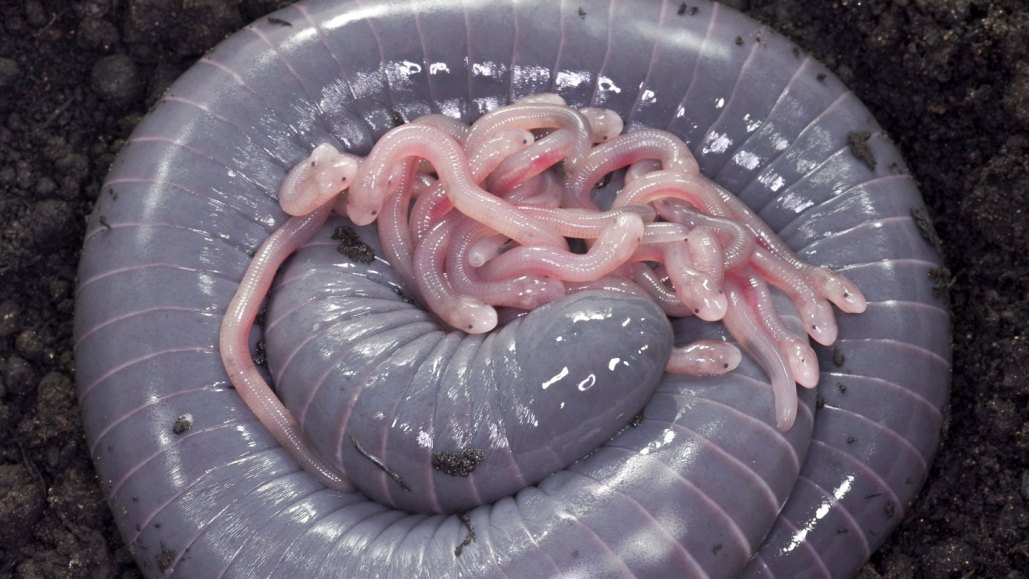First egg-laying amphibian discovered to nourish babies with 'milk'

Deep in a humid coastal rainforest during the night, a brood of pink, hairless offspring snuggle against their mother. They squirm and squeal for milk, which their mother provides, and they are satisfied. But these are not puppies or cubs. They have the form of snakes and are amphibians that are far more similar to frogs than foxes.
According to a report in the March 8 Science, these ringed caecilian mothers feed their young a form of “milk” created in the reproductive tract. These long, cylindrical beings are the first known egg-laying amphibians to nourish their young in this manner. This discovery suggests that the evolution of parental care across the animal kingdom is more diversified than researchers previously believed.
Despite possessing very few noticeable external features, caecilians possess a wealth of unusual biology. These elusive, nearly blind, legless, burrowing amphibians have some species, such as the ringed caecilian (Siphonops annulatus) featured in the new study, produce toxic slime, might contain venom and provide their skin as food for their offspring.
The Instituto Butantan's herpetologist Carlos Jared and his team in São Paulo have spent years researching these unique creatures. Past research revealed that ringed caecilian hatchlings, under the care of their mother for the first two months after hatching, usually congregated near the shared entrance of her reproductive, digestive and urinary systems, which is known as the vent. The babies often fed on a thick fluid that she periodically discharged from her vent.
Jared mentions that “Some [young] even tucked their heads inside the vent."
In their latest study, the team collected 16 female caecilians with their newly hatched litters from Bahia state in Brazil and observed them in a lab setting. Over 240 hours of video footage was taken, documenting the interactions between the amphibians. In the footage, 36 feedings were recorded, most consisting of the young ones squirming and nipping at their mother's vent while making high-pitched noises, with the mother responding by lifting her rear end and discharging the fluid. This occurred up to six times a day and seemed to be in response to the babies’ cries.
Mark Wilkinson, an evolutionary biologist at the Natural History Museum in London, finds the phenomena of squeaking and begging particularly intriguing since the adult caecilians were previously believed to only detect lower sound frequencies.
The researchers also studied the internal anatomy of some adult female caecilians and analyzed the nutritional and biochemical composition of the nutritional fluid. This fluid, loaded with fats similar to mammalian milk, is secreted by glands in the mother’s oviduct which enlarge while nursing her offspring. This plentiful nourishment could help explain the fast growth rate of the hatchlings, gaining up to 130 percent additional mass, approximately 0.27 grams, in their first week after hatching, even though they never stray from their mother's side and only eat her skin every few days.
Isabella Capellini, an evolutionary biologist at Belfast's Queen’s University, ponders whether there may be competition amongst the young for access to milk and how such contest might work out. It would also be interesting to study how the production of milk impacts the caecilian mother.
She shares, "In mammals, the lactating period is the most costly stage for the mother in terms of reproduction. It would be helpful to research whether milk production has similar costs for caecilians. What is the short- and long-term effect on the mother?"
Current knowledge does not enlighten us as to how these amphibians developed their version of “milk". This substance is relatively uncommon in the animal kingdom, being found other than in mammals and some caecilians, only in certain spiders, fish, cockroaches, birds, and two species of live-bearing amphibians.
These egg-laying caecilians' oviducts behave similarly to those of live-bearing species, which sometimes feed their offspring a milky substance while in-utero, but do not continue feeding them after they are born.
Wilkinson suggests that “This makes it easier to conceive of how [live-bearing] could have evolved from [egg-laying] species that already used their oviducts to produce food. We really have learned a lot about caecilians in the last few decades, but we are only seeing the tip of the iceberg.”




